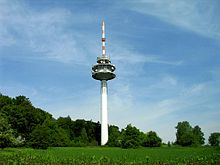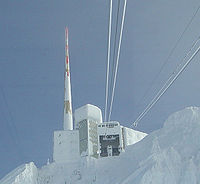European Aviation Network

The European Aviation Network is a hybrid network developed by Deutsche Telekom , Inmarsat and Nokia to provide broadband internet for aircraft across Europe . A combination of LTE radio from the ground and a satellite connection from space is used. For example, data rates of 75 Mbit / s downstream and 20 Mbit / s upstream can be achieved per aircraft . By the LTE wireless network, packet round-trip time (RTT) is reached ms in the range of 20 ms to 70 wt. With these data transfer rates and round-trip packet times, passengers can surf the Internet smoothly in the aircraft. In the aircraft itself, the Internet is then passed on to the passengers in the form of WLAN access points.
The European Aviation Network is the first fully integrated and pan-European LTE network worldwide.
history
The European Aviation Network was first announced jointly by Deutsche Telekom and Inmarsat in 2015. The Finnish company Nokia was not yet named as a technology partner at the time. On June 28, 2017, after delays, Inmarsat launched its first EAN satellite HellasSat 3 / Inmarsat-S-EAN with an Ariane 5 rocket and was thus able to start testing the network. In spring 2018, all three companies announced that they would then start the service commercially with the International Airlines Group .
technology
Conventional base stations of the terrestrial mobile radio providers are normally optimized for reception on the ground. For example, sector antennas of base stations of the terrestrial mobile phone providers are aligned to the ground (the so-called downtilt). Cell phone reception on an aircraft with a terrestrial cell phone provider is therefore not possible at high altitudes.
The specially expanded EAN base stations from the European Aviation Network are optimized for reception in the aircraft. According to Deutsche Telekom , the EAN ground network relies on 300 EAN base stations that are distributed across the 28 EU member states as well as Norway and Switzerland . EAN base stations are usually located on elevated locations such as mountains or transmission towers with great visibility all around; in Switzerland, for example, these are on Monte Generoso on the Säntis and on the Chasseral .
These EAN base stations are operated with modified LTE technology, the parameters of which are adapted to use with aircraft. The network supports speeds of up to 1200 km / h and an altitude of up to 12 km. Since additional effects such as the Doppler effect come into play at such speeds , the hardware of the radio modems must be designed for this. In addition to a classic LTE modem, there is an extra remote radio head in the aircraft that compensates for the frequency shift due to the Doppler shift in both directions, i.e. downstream and upstream.
The cell radius is significantly larger in EAN-LTE than in LTE networks for ground networks. In the EAN network, for example, a radio cell has an average radius of 80 km to 100 km. The maximum cell radius is 150 km.
If the LTE ground network cannot be reached, for example because the aircraft is just above the sea, the satellite network provided by Inmarsat is used. For this reason, aircraft equipped with the EAN have a cellular antenna under the fuselage as well as a cellular antenna on top of the aircraft.
The aircraft roof antenna uses the S-band for the satellite connection . For the satellite link, a bandwidth of 15 MHz in the frequency range from 2170 MHz to 2185 MHz is used for the downlink and a bandwidth of 15 MHz in the frequency range from 1980 MHz to 1995 MHz for the uplink .
The aircraft fuselage antenna uses the E-UTRA frequency band 65 in the same frequency range as the roof antenna for the terrestrial LTE radio connection . A bandwidth of 15 MHz (13.5 MHz usable bandwidth plus 0.75 MHz guard band above and below) in the frequency range from 2170 MHz to 2185 MHz for the downlink and from 1980 MHz to 1995 MHz is also required for the terrestrial LTE radio link used for the uplink. Commercially available cell phones only support cell phone reception in E-UTRA frequency band 1, but not the extended E-UTRA frequency band 65. Roaming between public LTE cell phones for ground reception and the European Aviation Network is not supported.
The cell radius and range of a terrestrial LTE base station is around 9 km. Due to the maximum cell radius of 150 km of an EAN base station, the range of the LTE radio signal emitted by the aircraft fuselage antenna or the EAN base station must be up to 150 km. Because of the free space attenuation , the maximum transmission power of the aircraft fuselage antenna must be significantly higher than that of an LTE mobile phone for terrestrial mobile communications. An LTE mobile phone for terrestrial mobile communications transmits with a maximum transmission power of 200 mW (23 dBm ). The LTE radio signal in the EAN to be emitted via the aircraft fuselage antenna is generated by a remote radio head, along with the necessary frequency offset to compensate for the Doppler effect. The remote radio head for the EAN aircraft fuselage antenna transmits with a maximum transmission power of 5 watts (37 dBm).
As a rule, three sector antennas in the 3 × 120 ° configuration are used for the EAN base stations. The sector antennas of the EAN base stations are directed towards the sky. The sector antennas of the EAN base stations are aligned and optimized for reception at an altitude of 3000 to 10000 meters above sea level . The maximum transmission power per sector antenna is 2 × 40 W (46 dBm). Thanks to MIMO, there are two linearly polarized transmitting antennas with a polarization of ± 45 ° in each sector antenna .
The EAN network uses the MCC / MNC tuple 901-53 assigned to Deutsche Telekom by the ITU .
HellasSat 3 is in geostationary orbit at 39 ° East.
Locations of the EAN
Airlines
Airlines that support the European Aviation Network as of early 2018:
- British Airways (IAG)
- Iberia (IAG)
- Aer Lingus (IAG)
- Vueling (IAG)
- Lufthansa (LH)
Web links
- European Aviation Network (EAN) General website
- European Aviation Network (EAN) media kit from Deutsche Telekom
- European Aviation Network (EAN) website from Inmarsat (English)
- EAN Satellite Missions eoPortal Directory from ESA (English)
Individual evidence
- ↑ https://www.telekom.com/resource/blob/514346/a230e29da337c92fe8efa2261b4ce41b/dl-press-conference-ean-5-feb-18-data.pdf European Aviation Network - Online Press Conference 5th February (pdf , 4.5 MB)
- ↑ https://www.telekom.com/resource/blob/514362/573766b5820f07e7fbcb1d3b18a2b94a/dl-ean-factsheet-data.pdf Fact sheet: EAN benefits at a Glance (English) (pdf, 152.5 KB)
- ↑ https://www.youtube.com/watch?v=m0H7ZXtztkM
- ↑ https://eoportal.org/web/eoportal/satellite-missions/content/-/article/ean
- ↑ http://space.skyrocket.de/doc_sdat/hellassat-3-inmarsat-s-ean.htm
- ↑ https://www.hardwareluxx.de/index.php/news/software/browser-und-internet/36637-lufthansa-will-wlan-auf-innereuropaeischen-fluegen-anbieten.html
- ↑ https://www.heise.de/newsticker/meldung/Schnelles-Internet-fuer-Flugzeuge-in-Europa-ist-startklar-3960771.html
- ↑ http://www.ralf-woelfle.de/elektrosmog/redir.htm?http://www.ralf-woelfle.de/elektrosmog/technik/antennen_3.htm
- ↑ https://www.heise.de/newsticker/meldung/Schnelles-Internet-fuer-Flugzeuge-in-Europa-ist-startklar-3960771.html
- ↑ https://www.telekom.com/de/medien/mediencenter/fotos/fotos-european-aviation-network
- ↑ https://www.telekom.com/de/medien/mediencenter/fotos/fotos-european-aviation-network
- ↑ https://www.telekom.com/de/konzern/details/highspeed-ueber-den-wolken-500790
- ↑ https://www.swisscom.ch/de/business/broadcast/ueber-uns/newsletter/newsletter-archiv/2017_4_t03.html
- ↑ https://www.telekom.com/de/medien/mediencenter/fotos/fotos-european-aviation-network
- ↑ https://www.telekom.com/de/konzern/details/highspeed-ueber-den-wolken-500790 Highspeed above the clouds: on the way to the European Aviation Network - Deutsche Telekom
- ↑ https://www.telekom.com/resource/blob/514356/e7234ece88a9fae5b4346c2633bf30d7/dl-ean-faq-data.pdf European Aviation Network: Q&A (English) (pdf, 405.3 KB)
- ↑ https://www.inmarsat.com/wp-content/uploads/2016/01/Inmarsat_European_aviation_network_April_2016_EN_LowRes.pdf
- ↑ https://www.golem.de/news/ka-ku-und-ean-s-band-das-schnelle-flugzeug-internet-wird-realitaet-1705-127309.html
- ↑ https://www.bundesnetzagentur.de/SharedDocs/Downloads/DE/Sachgebiete/Telekommunikation/Unternehmen_Institutionen/Frequenzen/SpezielleAn Zeiten/Satellitenfunk/ 20160713_EAN_telekom_PDF.pdf Answer from Deutsche Telekom AG to the public hearing of the Federal Network Agency on the Inmarsat business model "in the 2 GHz frequency range
- ↑ http://www.erodocdb.dk/Docs/doc98/official/pdf/ECCDEC0609.PDF
- ↑ https://www.bundesnetzagentur.de/SharedDocs/Downloads/DE/Sachgebiete/Telekommunikation/Unternehmen_Institutionen/Frequenzen/SpezielleAn Zeiten/Satellitenfunk/20180314_EAN_KonkretisierendeZutgabe_PDF.pdf?__blob=publication "Nr. 66 Official Journal-Announcement-Official Gazette-Announcement-Official Gazette-8" Bundesnetzagentur. European Aviation Network (EAN) of March 14, 2018 "in the MSS 2 GHz frequency range
- ↑ https://www.bundesnetzagentur.de/SharedDocs/Downloads/DE/Sachgebiete/Telekommunikation/Unternehmen_Institutionen/Frequenzen/SpezielleAn Zeiten/Satellitenfunk/ 20160713_EAN_telekom_PDF.pdf Answer from Deutsche Telekom AG to the public hearing of the Federal Network Agency on the Inmarsat business model "in the 2 GHz frequency range
- ↑ http://www.erodocdb.dk/Docs/doc98/official/pdf/ECCDEC0609.PDF
- ↑ https://www.telekom.com/de/konzern/details/highspeed-ueber-den-wolken-500790 Highspeed above the clouds: on the way to the European Aviation Network - Deutsche Telekom
- ↑ https://www.etsi.org/deliver/etsi_ts/136100_136199/136101/13.03.00_60/ts_136101v130300p.pdf ETSI TS 136 101 (English)
- ↑ http://aceaxis.co.uk/thales-selects-aceaxis-radio-to-power-in-flight-broadband/
- ↑ https://www.ip-insider.de/nokia-fiebert-raketenstart-entgegen-a-574315/ IP Insider - Nokia is excited about the rocket launch
- ↑ https://www.telekom.com/de/medien/medieninformationen/detail/european-aviation-network---installation-der-ersten-lte-antennen-in-england-439090 European Aviation Network - Installation of the first LTE Antennas in England - media report from Deutsche Telekom
- ↑ https://www.flugrevue.de/flugzeugbau/systeme/european-aviation-network-lte-haben-ab/716572 European Aviation Network: LTE takes off - FlugRevue
- ↑ https://www.telekom.com/de/konzern/details/highspeed-ueber-den-wolken-500790 Highspeed above the clouds: on the way to the European Aviation Network - Deutsche Telekom
- ↑ https://www.bundesnetzagentur.de/SharedDocs/Downloads/DE/Sachgebiete/Telekommunikation/Unternehmen_Institutionen/Frequenzen/SpezielleAn Zeiten/Satellitenfunk/ 20160713_EAN_telekom_PDF.pdf Answer from Deutsche Telekom AG to the public hearing of the Federal Network Agency on the Inmarsat business model "in the 2 GHz frequency range
- ↑ https://www.itu.int/dms_pub/itu-t/opb/sp/T-SP-E.212B-2018-PDF-E.pdf
- ↑ https://www.computerbase.de/2018-02/ean-internet-lufthansa/







